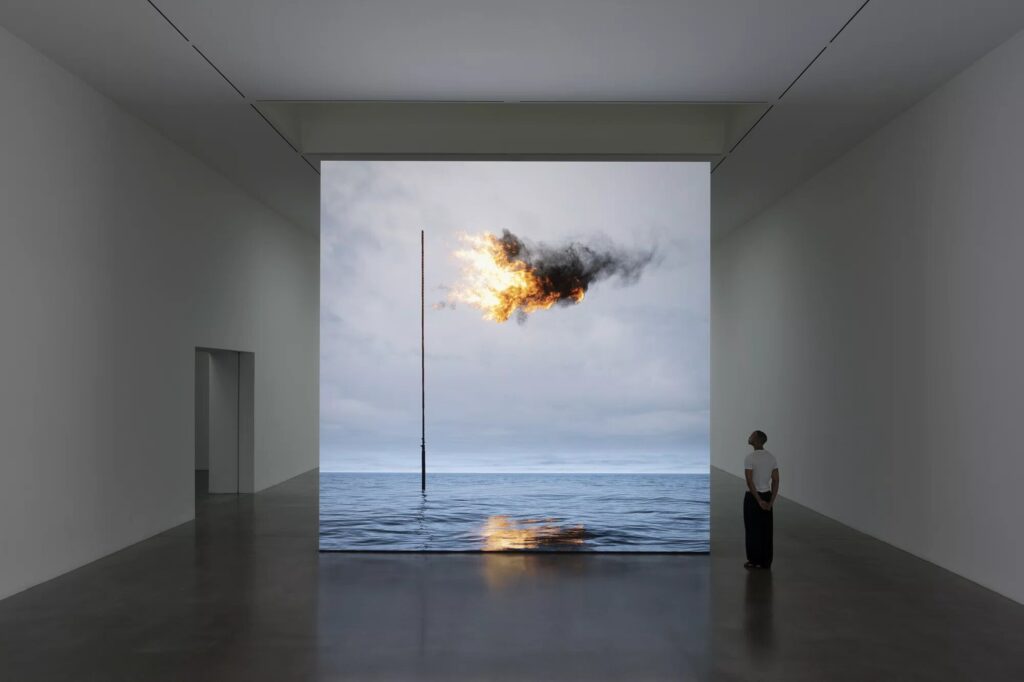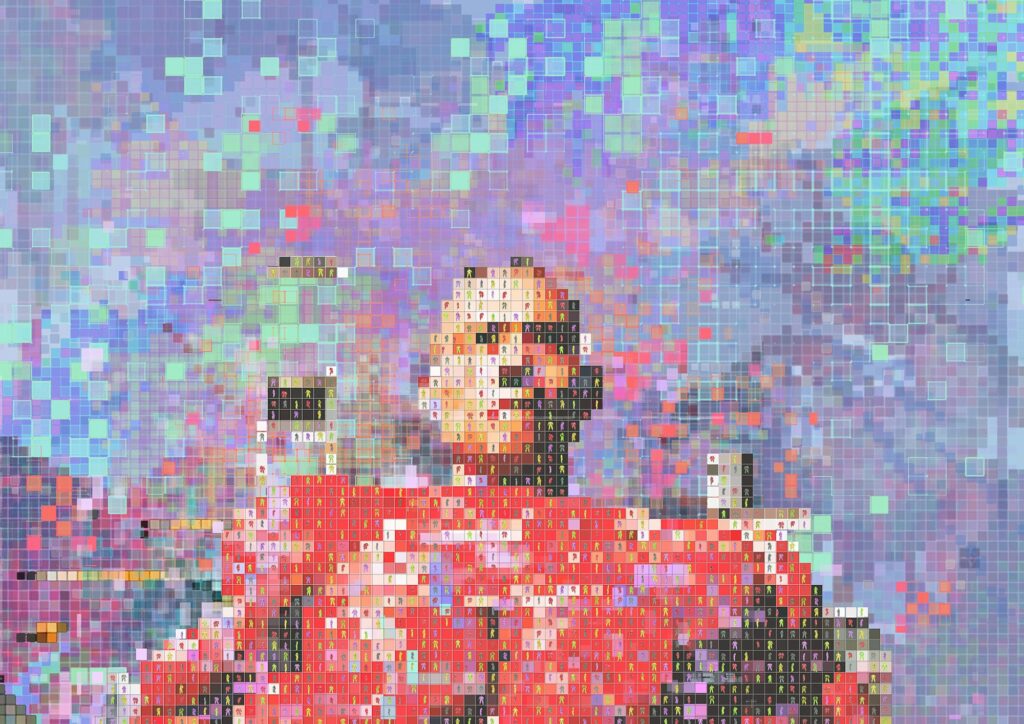
10 Artists Revisiting the Curtain in Contemporary Art
Contemporary Art Trends
Digital art refers to any form of artistic work or practice that utilizes digital technology as an essential part of its creation or presentation. It includes various media, such as digital painting, 3D modeling, video art, generative art, and more. Digital art can be displayed in multiple formats, including digital screens, projections, and online platforms, and often incorporates modern technologies like artificial intelligence, augmented reality, and virtual reality to expand artistic expression. The arrival of new technological possibilities did not go unnoticed by artists. In the 1960s and predominantly in the 1980s, technology was used to create art; thus, digital art was born.
Ever since digital art has earned its place in the art world throughout history, as the publication Digital Art published by Phaidon illustrates so comprehensively—a key reference publication for anyone who is interested in digital art. The digital was always a means of expression, a tool, a process, and a concept, but not the final medium. The digital became art if it was, in the end, presented in an existing artistic discipline: a video installation, a fine art print, an immersive environment, a new media sculpture, et cetera. Simultaneously, in 2010, new forms of digital art emerged outside of the traditional art world, such as digital painting, which was closely related to video games and digital illustration. However, an artwork that is 100% digital seemed to be impossible due to a lack of collectibility. Enter NFTs.
Non-fungible tokens (NFTs) are unique digital assets stored on a blockchain that represent ownership or proof of authenticity for a specific item, such as art that is 100% digital. NFTs were invented in 2014 but only gained significant attention around 2017, followed by an astronomic rise in 2019. Unlike cryptocurrencies like Bitcoin or Ethereum, which are interchangeable or “fungible,” NFTs are one-of-a-kind and cannot be replaced by another identical item. Each NFT contains metadata that distinguishes it from other tokens, making it suitable for certifying digital ownership, provenance, and scarcity, and thus becoming a key part of the digital art and collectibles market.
Due to the arrival of NFTs, art that is 100% digital was able to enter the art market, and the 2021 NFT boom brought art and tech industries together. However, before we discuss the collapse of the NFT market, it is important to state that empirical evidence shows that digital art is predominantly popular in the institutional realm of the art world dominated by multidisciplinary artists encompassing experiential and immersive installations, augmented reality, and video works—which is actually what we noticed in our complete article discussing the top 20 digital artists today.
Stand-alone digital artists producing two-dimensional visuals are finding it incredibly difficult to enter the art world. First and foremost, despite NFTs, the lack of a physical object remains the main culprit, as it is more difficult to sell or fall in love with a digital file than with a tangible painting. People find it difficult to pay good money for it, especially when the trading value is unsure. Therefore, there are almost no profit margins for galleries, pushing digital art towards the institutional and multidisciplinary once more. But, there is also a cultural barrier between the digital and the art world. The digital can become art when it is pulled from the periphery to the center by established artists or established disciplines. However, vice versa, digital art as digital art being pushed to the center seems to be a lot harder.
Ironically, digital art can often require more skill than photography, yet a printed photograph will be more appreciated in the art world than a printed digital artwork. This all has to do with the background of both media. Photography is rooted in an ongoing art historical tradition of fine art. Digital art, such as AI images, NFTs, or digital painting, on the other hand, is related more to illustration, commercial art, and the gaming industry. Therefore, the aesthetics, the process, the artist’s persona, and the overall scene do not align that well with the art world. And even more, with the arrival of AI image generation, an even larger shadow is cast upon digital art, as we can never know for sure or with an inexperienced eye if the artwork was machine-made or man-made. In the end, it shouldn’t matter. But, for the market, for the people, it still does.

However, what about all those overwhelmingly positive articles and news flashes of established artists, galleries, and auction houses using NFTs? Also, it has been a while since we have heard new ground-breaking records from the NFT space, so what is the current state of the NFT market? And what is the part of the NFTs in the global art market and art world?
Let’s run it back first. Beeple’s Everydays: The First 5,000 Days sold for $69.3 million in March 2021, making him the third-most-expensive living artist. This was a true heyday of NFTs, and a lot of great money was made with the highest peak in January 2022 driven by speculation, resulting in incredibly eye-catching stories of self-taught and unknown digital artists going from rags to riches in days thanks to NFTs and without the traditional art world.
However, by September 2022, NFT transactions had dropped by 97% from their peak eight months earlier. Even more, digital art is still a really small part of the art market when looking at the bigger picture, as just 0.2% of the total value of the art market consists of digital art. Within this small percentage, the bulk of NFTs consists of non-art-related NFTs, such as images of punks, kitties, and monkeys, which means only 0.03% of the global art market are art-related NFTs.
Although the 2021 NFT boom brought art and tech industries together, the two sectors have since diverged, with many in the Web3 space now focused on meme coins and social media platforms like Farcaster rather than digital art. Furthermore, the strong presence of NFT-related scams and the high percentage of lost NFTs don’t help the NFT space to enter the high-end art world. Artist Anne Spalter, a victim of crypto market volatility, believes that some centralization is better for digital art, especially to avoid security issues like theft and scamming in the Web3 space. After a couple of launches of JR, Damien Hirst, or König Galerie jumping on the bandwagon—which in the end often remained one-time events—today, the NFT space is still a bit dubious with leaders in the digital art space, such as Pace Verso and Art Blocks, distancing themselves from the term “NFT” due to its negative connotations, preferring to emphasize the art over the technology.
Yet, despite the crash, institutions like the Centre Pompidou have acquired NFTs, and museums and auction houses still exhibit and sell them. Even more, Bitcoin hit an all-time high of $73,000, and notable NFT art sales at Christie’s, MoMA, and Sotheby’s totaled over $975,000, and it seems like the NFT space is currently running on a lower but more sustainable economic level. But the overall tendency is that despite some renewed interest, the art community is cautious about NFT trends. Art professionals are focusing more on the artwork itself rather than the mechanics of NFT sales. It doesn’t make any sense that the market value of art should depend on the popularity and volatility of block-chain technology and crypto; it should be determined by the artistic and historical quality, which is exactly what made blue-chip artists blue-chip artists, drawing a telling comparison with blue-chip stocks that are high-quality investments that enjoys public confidence in its worth and stability.

Numerous artists who have had some success in the NFT space are considering shifting to the traditional art world with their art. First and foremost, they are doing so because the NFT market frankly collapsed in value almost overnight. But they also wish to do more than just mint and flip and achieve a deeper appreciation and interaction with art enthusiasts whilst building a more sustainable career as a creative individual. However, the latter must be the main motivation, because this shift is not as easy as many would hope or think. Art world success is not a rags-to-riches path as NFTs were at a certain point. There are simply no shortcuts in this long-term game.
But yes, digital and NFT artists can make this career transition happen. First and foremost, one must profile oneself as an artist, not a digital artist or NFT artist—especially considering the rather dubious connotation connected to NFTs. Instead, you are a contemporary artist and NFTs or digital works are one of perhaps multiple artistic disciplines you practice. This brings us to another important step or shift one must consider: shifting from creating digital-only artworks to creating collectible objects. Think of painting your digital artwork on canvas using oil paint. Or printing your image in 2D on paper, canvas, or panel or in 3D on plastic, ceramics, or metals. Or what about turning your animations into video installations or even experiential and immersive environments?
This is the main hurdle most NFT artists are unwilling to take because it takes a lot of time, there is a technical learning curve, one must have a studio, there are more costs, and it can take a lot of space simply to store your works. However, if you are not willing to take this step and really commit to this shift, then it will simply never happen. Digital artists who have resorted to painting or analog printing techniques to translate their digitally rendered images into tangible, physical—and thus collectible—art objects have been able to enter the high-end art world. There are plenty of examples here: Chris Finley, Joseph Nechvatal, and Emma Webster. We see the same thing with more video-based and immersive digital artists, such as Lu Yang, Operator, and Refik Anadol. In short, we are able to enter art forms from the periphery, such as digital art, into high art by engaging with existing artistic formats, disciplines, or histories, but not vice versa.
Another crucial aspect is your subject matter. Too often, within digital art, digital illustration, and the NFT space, the value or quality of the artwork is predominantly focused on the technology or the visual spectacle. In the art world, the subject matter, the backstory of the artwork and artists, and the overall conceptual foundation exemplified by the entirety of the cohesiveness of the oeuvre are essential. Focusing on creating something visually spectacular is never enough, making the expectations or quality standards different from the NFT space. We need to be able to go beyond the surface or façade but also beyond the technology. We need to create works that have the potential to become a conversation piece. Understanding and practicing this historical language and tradition of the semantics of art, iconography, and ‘oeuvre building’ are crucial skills to do this successfully—but this comes, of course, once more with a rather steep learning curve.
And then there are a set of chores when it comes to professionalizing your profile as a contemporary artist and building your network and visibility to get seen in the right manner by the right people. To find more information, feel free to consult our overview page advice for artists next. To conclude, for further reading on digital art and NFTs, I highly recommend Internet_Art: From the Birth of the Web to the Rise of NFTs by Omar Kholeif and NFTs Are a Scam / NFTs Are the Future: The Early Years: 2020-2023 by Bobby Hundreds and the utterly impressive Taschen publication On NFTs.
Last Updated on September 15, 2024

Contemporary Art Trends

A Complete Guide & Top 20

History, Pioneers & Leading Artists Today
Step-by-Step Guide & Examples